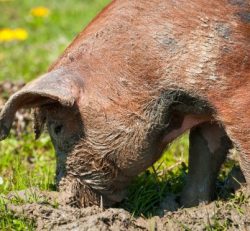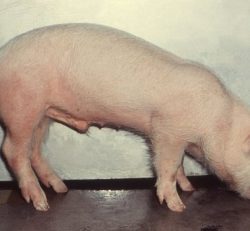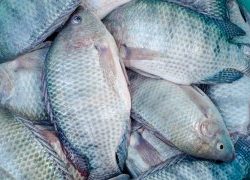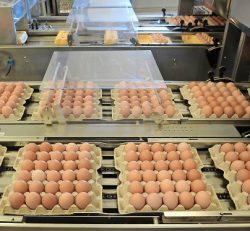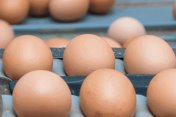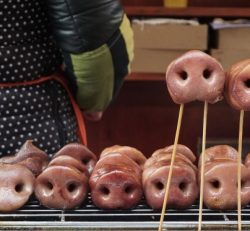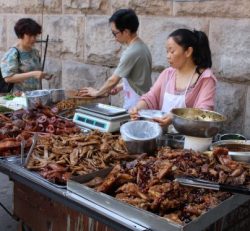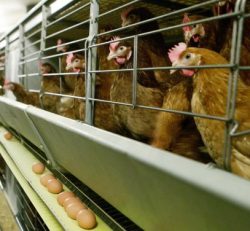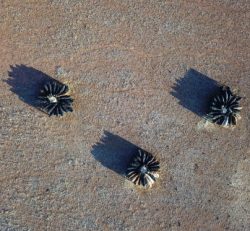BETTER SOW PERFORMANCE WITH THE RIGHT MINERALS
Times are long gone when supplying minerals to pigs was a matter of one-size-fits-all. Sows have a different demand, depending on their parity, size and litter size. Supplying correct amounts will enhance sow performance, with benefit for her piglets too.
Minerals are important for maintaining the body and ensuring animal performance. In breeding sows, certain minerals are needed for successful conception and parturition. Chromium is needed to produce insulin, which affects progesterone production, as well as influencing follicle stimulating and luteinising hormones. Both hormones are required for regulating ovulation and have a direct impact on fertility and litter numbers. Manganese is required for progesterone production, whilst iron and chromium are required for further hormone activity, which influences embryo survival during the pregnancy. Uterine capacity, which dictates the number of piglets born, requires appropriate feeding levels of selenium, iron and chromium.
Breeding animals have higher mineral requirements, as they have to produce ova that are robust enough to achieve conception, supply developing foetuses with minerals for correct development and, in the case of mammals, produce milk to suckle their young. As such, breeding sows can often be deficient in mineral intake, especially when tissue reserves are depleted.
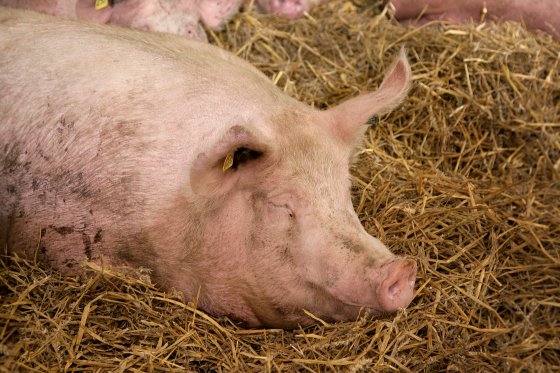
The levels and types of minerals used in sow diets are also important to secure their reproductive performance. Photo: Hans Prinsen
Sows producing large litters
Modern pig genetics have created sows that can produce higher litter numbers, heavier piglets and lower progeny mortality. Nutrition has had to change in order to keep up with this increased reproductive capacity of sows. Reviews of feeding trials have shown that actual requirements can be much higher than National Research Council (NRC, 1998 & 2012) recommendations (see Table 1).
Even over the relatively short space of time between 1998, when the NRC recommendations were published, to 2003, when the British Society of Animal Science conducted their review of mineral data, and the next NRC recommendations in 2012, requirement levels have increased significantly. This is especially evident for minerals involved in antioxidation, such as zinc, copper and selenium, which is important in high performing animals, which have increased oxidative damage from the generation of free radicals from higher metabolic functions.
Table 1 – Mineral requirements in sows compared toNRC (mg/kg) (1998 & 2012).
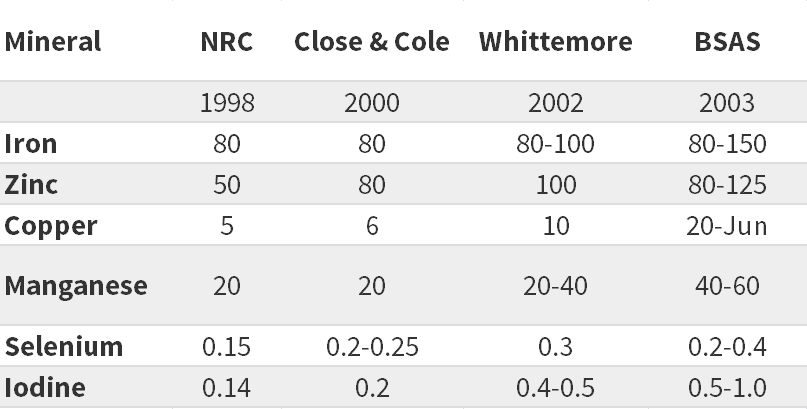
By Pig Progress
The proper provision of antioxidants through feed is important for protecting cell membranes, especially in vulnerable, rapidly replicating cells such as ova and embryos. Other research investigated the requirement of sows over subsequent parities and reported a 16% increase in the levels of iron, zinc and copper and a 14% increase in manganese for sows at parity 3 or more with a body weight of 240kg, compared to first parity dams weighing 160kg.
Table 2 – Mineral provision for the breeding sow(mg/kg).
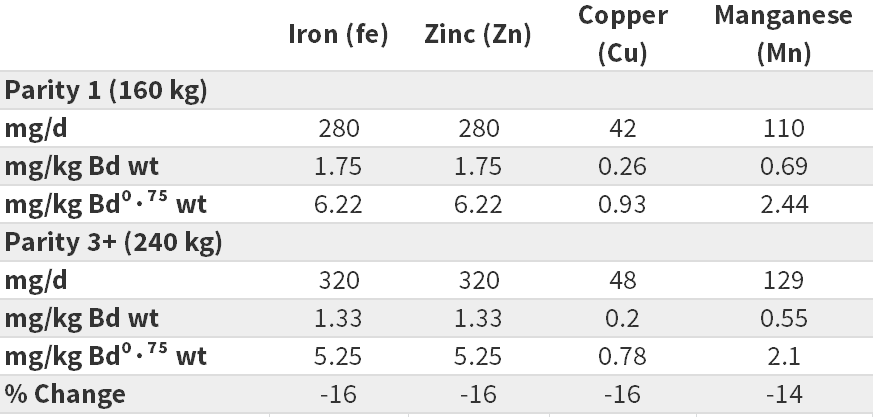
By Pig Progress
Other mineral studies have shown that parity number has an impact on haemoglobin concentrations in sow blood, which is related to iron loss over time. Iron is an essential component of haem, which is required for the efficient uptake of oxygen into red blood cells and delivery to tissues and organs. These low haem levels are reflected in the litters of piglets from these sows, which can be detrimental to their health and growth performance. In addition, sows need to have efficient oxygen transport around the body to prevent fatigue, such as during farrowing.
It is apparent that diets must be formulated by parity to replace lost nutrients after each litter and to ensure the sow always has adequate levels of minerals in tissue reserves in preparation for the demands of the next pregnancy. Sows fed diets containing the commercial organic mineral products Bioplex had, on average, 0.5 more live piglets per litter, as calculated from responses from trials run in 19 different countries, and more than 1kg heavier birth weights.
Organic minerals
Minerals can be supplied in the inorganic form (as oxides or sulphates), or as chelated ‘organic’ minerals, which are bound to small proteins more akin to how minerals appear naturally in feedstuffs. Organic minerals have been shown to be selectively taken up from the gut in animals and have better tissue storage. Feeding organic forms of selenium (Sel-Plex) to sows increased liver selenium levels by 21% compared to feeding inorganic sodium selenite. In sows, feeding organic forms of iron have been shown to increase the transfer of iron across the placenta into the developing piglet foetuses. This results in stronger piglets at birth with better milk intakes.
Figure 1 – Haemoglobin concentration in sow’s blood.
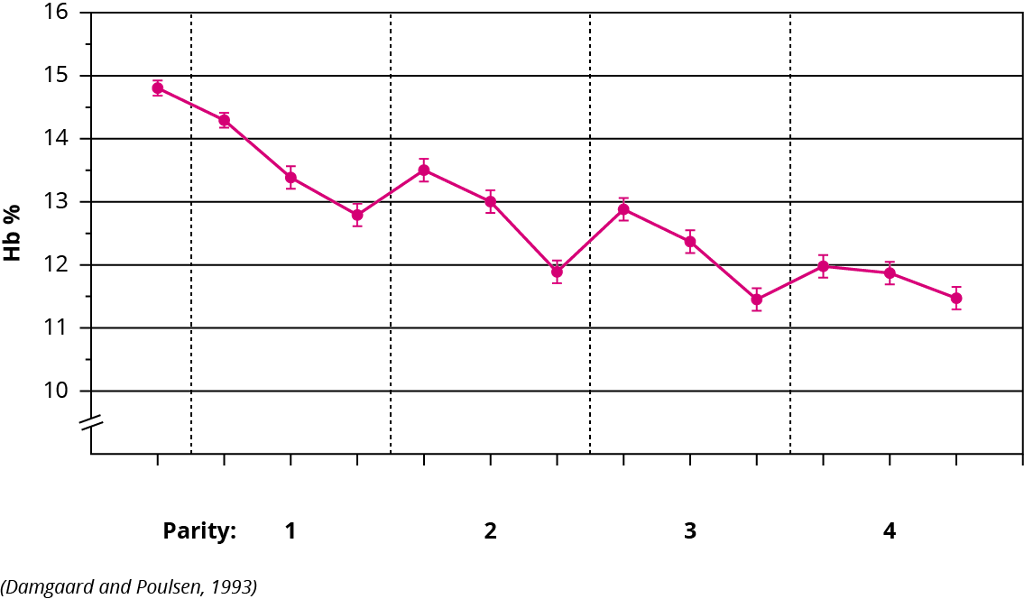
In addition, sows with higher iron status that produce more viable piglets have higher colostrum and milk yields in response to the stronger suckling behaviour. A feeding trial using a chelated iron product in sow diets conducted in 1998 showed that 10% more piglets weighed 6.5kg or more at weaning, with 8% fewer classified as ‘light’ (<5.5kg) at this age. in a review of the effects of this iron supplement on piglet weight from six different countries, research from 2004 showed consistently higher weaning weights in piglets from sows receiving organic minerals versus an inorganic mineral control diet. feeding the ‘bioplex sow pak’ combined minerals product gave consistently higher weaning weights over ten parities studied, with mean weaning weight increased, on average, from 6.9kg for the control to 7.4kg.
Providing sows with inorganic versus organic minerals to levels recommended by either NRC (1998) or industry standard levels increased litter sizes by 0.4 and 1.5 animals, respectively. 5 Canadian farm trials with 10,000 sows per dietary treatment showed that feeding this combined minerals product increased farrowing rate by 1.8%, with 0.3 more litters per sow over her lifetime and over three more piglets weaned per litter. Non-productive periods were reduced by nearly nine days and sow culls were down by 2%. Supplementation with zinc, copper and manganese in this context is important for hoof strength.
The levels and types of minerals used in sow diets are important not only for the healthiness and longevity of the sows, but also to secure their reproductive performance and ensure the delivery of robust piglets. Modern breeds have higher requirements compared to the standard NRC (1998) levels, and both controlled and commercial trials have shown the benefits of using organic forms of minerals over traditional inorganic sources. The organic forms are better absorbed from the gut and stored in tissues, making them more bioavailable to the sow. Re-evaluating mineral requirements in sows and replacing inorganic forms with chelated organic versions can increase number of successful parities, reduce culls and increase the number of piglets per litter and their weaning weight, all contributing to animal health and welfare as well as farm profitability.
Sources available upon request.
Dr Jules Taylor-Pickard
Alltech
Source: www.pigprogress.net


